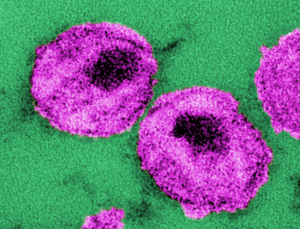Original Title: 84-617-HIV
Date: ??
Courtesy Dr. A. Harrison; Dr. P. Feorino
This thin-section transmission electron micrograph (TEM) depicted the ultrastructural details of two Óhuman immunodeficiency virusÓ (HIV) virus particles, or virions. A member of the genus Lentivirus, HIV is separated into two serotypes, HIV-1 and HIV-2, and is the cause for the disease known as acquired immunodeficiency syndrome, or AIDS. This virus may be passed from one person to another when infected blood, semen, or vaginal secretions come in contact with an uninfected personÕs broken skin or mucous membranes*. In addition, infected pregnant women can pass HIV to their baby during pregnancy or delivery, as well as through breast-feeding. People with HIV have what is called HIV infection. Some of these people will develop AIDS as a result of their HIV infection.
What is AIDS?
AIDS stands for Acquired Immunodeficiency Syndrome.
Acquired Ð means that the disease is not hereditary but develops after birth from contact with a disease causing agent (in this case, HIV).
Immunodeficiency Ð means that the disease is characterized by a weakening of the immune system.
Syndrome Ð refers to a group of symptoms that collectively indicate or characterize a disease. In the case of AIDS this can include the development of certain infections and/or cancers, as well as a decrease in the number of certain cells in a personÕs immune system.
A diagnosis of AIDS is made by a physician using specific clinical or laboratory standards.



